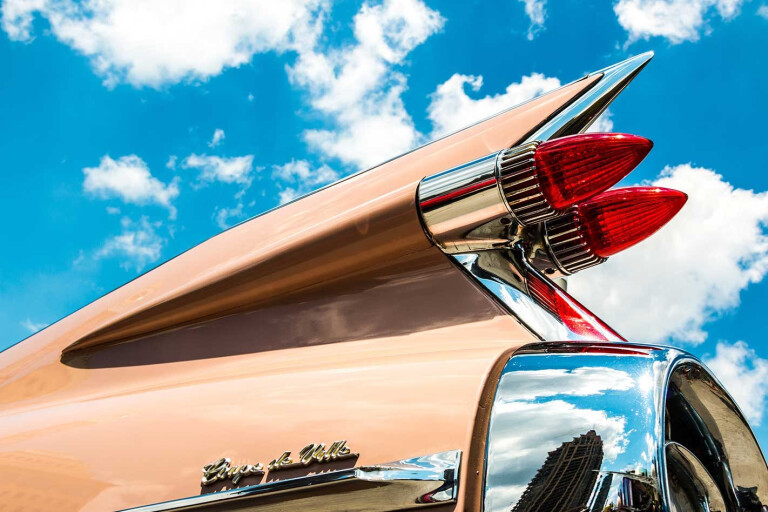
Close your eyes and think of the coolest car you can imagine. Odds are it is low-slung and maybe it’s pointy, with a long lean nose, fierce oversized wheels and some crazy angles that suggest speed. There’s a good chance it has gull-wing doors, or an open top. Perhaps you’ve had dreams of a super-chunky Jeep with articulated rock-crawling wheels and massive bucket seats. Or, perhaps, a Lady Penelope-type chariot with fins, dashes of chrome and oodles of royal flourishes.
Now, open your eyes. Can you see any car on the road that comes close to the shape and detail in your head? Unless you’re looking at a Lamborghini Aventador in stealth matte grey, a Land Rover Defender on steroids, or a 1958 pink Chevy Bel Air, then the answer is no.
So why, when consumers crave sharp folds and shiny ornaments, are today’s cars so rounded and squashy? And where did all the flashy grilles, lights and hood ornaments go?
Take tail fins for example; a classic fantasy-car detail. Inspired by WWII fighter planes, General Motors designer Harley Earl created them for his 1948 Cadillac. Other American automakers followed, using jet turbine detailing and lashings of chrome. There was suggestion that tail fins added weight to 'stabilise' those yank-tanks. A couple of makers experimented with central dorsal fins and Mercedes added them as 'sight lines' for reversing.
So where are fins they now? Turns out that the pointed 'jet wing' is lethal to pedestrians and is at just the right height to take out children. ’Nuff said.
Pop-up headlights were first used in the 1930s, but hit their stride in the 1970s when the technology allowed designers to drop the bonnets and pop the lights up. Some of my favourite sleek machines – Maserati Bora, Corvette Stingray, Lamborghini Countach and Monteverdi Hai 450SS – came from this era of barely-compromised form.
The beloved Mazda MX-5 was one of the last cars to sport pop-ups. Where's the downfall in a feature that offers uninterrupted lines, you ask? Well, a pop-up headlight would shred a pedestrian unfortunate enough to be scooped up onto the low bonnet.
Are you getting a feel for what killed the fun? That’s right, it was kids playing in driveways, adults jaywalking and people texting as they crossed busy roads.
Bonnet ornaments in the shape of stars and pouncing felines, once a mark of luxury, are now a mark of an out-dated car. Since the mid-2000s, carmakers have phased out hood ornaments because of the impact they can have on soft bodies.
Grilles have changed, too, because they can act like cheese graters on a hapless human. Bumpers, too, are designed to protect lower limbs.
What about those lumpy car forms? The whole front of the car is styled around keeping a pedestrian alive. That’s why the lines swoop and swerve like a slide at a water park, because they are maintaining a gap of around 10cm between the bonnet and the stiff engine parts, which significantly reduces massive head injury, while optimising aerodynamics and packaging.
Respect to the designers who can keep our unpredictable fellow critters safe and still make a car look good.
Sally Dominguez is a multi-award winning Australian product designer and architect now living in the USA. Her products include the Nest highchair and HOG tank. She is currently running her own Adventurous Thinking tools and strategies program.
COMMENTS